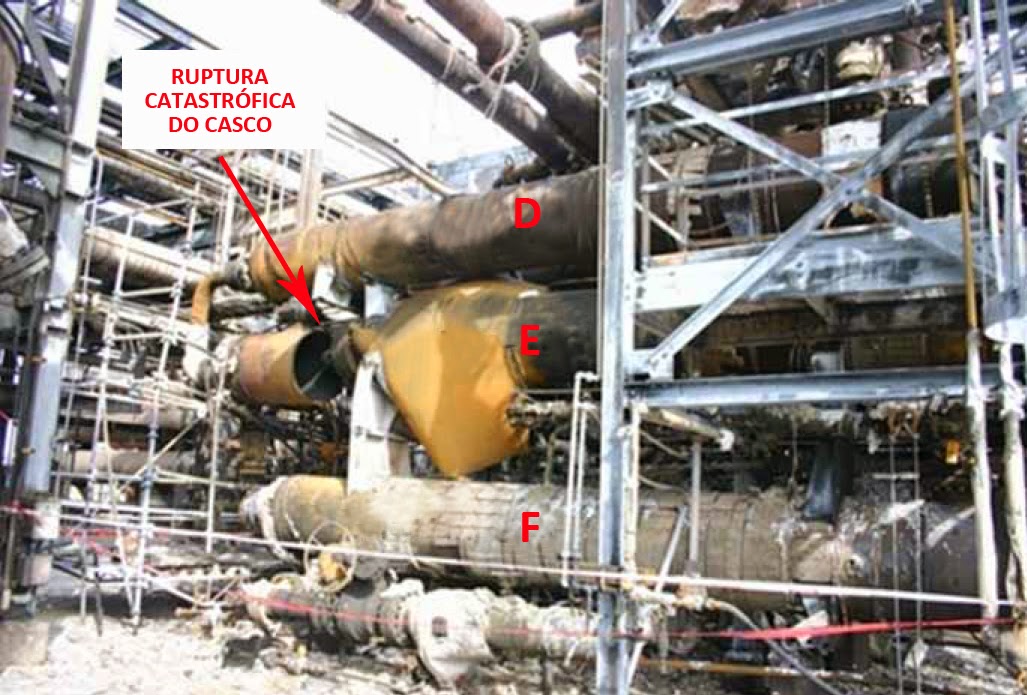Case 075: Breaking the pump
body.
On October 12, 2001, at 5h20m, an oil tank operator
located next to a dock the bank of the river Seine in the commune of
Hauts-de-Seine (nearby Paris), France, was alerted by a driver who heard a strange
noise in the pump station No. 1. By checking this alert, discovered a furnace
fuel oil spill (Furnace Fuel Oil - FFO) that flooded the pit retention of pump
station with about 80 cm of FFO.
The leak occurred in a tank farm consisting of 23 tanks, each with a
nominal capacity of between 537 m³ and 19 193 m³, for a total nominal capacity
of approximately 107,000 cubic meters.
CAUSES
The leak occurred in the No. 01 pump station where one of the bombs had
your body (housing) broken due to the accumulation of excessive stresses
associated:
·
Incorrect
support lines and accessories lines (suction and discharge);
·
Lines
incorrectly connected to the pump.
The phenomenon was exacerbated by the nature of the pump (made of cast
iron) which did not support the stresses caused by poor installation of the
pump in place and the resulting mechanical vibration.
Furthermore, leakage of the product is possible as the result of various
disorders:
·
A liquid
hydrocarbon detector was set at 2 meters pump in question, but were dead at the
time of the incident;
·
FFO was
intercepted by a "trap" the gravity equipped with a plug (floaters)
that prevented the spill reached the Seine, but as the closing was not
immediate, several hundred liters of FFO leaked to the Seine;
·
The pump in
question was a back-up pump that was not in operation at the time of the
incident, however, an error, which was subsequently identified as bad
operational management, the valves were kept open permanently.
AFTERMATH
About 500 liters of FFO was improperly dumped in the Seine a distance of
3 km from the spill source point (iridescence was found along this stretch).
The loss calculated by official agencies was about € 200,000 (euros) can
be specified as follows:
·
Damage to property: € 112,000;
·
Environmental decontamination /
cleaning costs: € 23,000;
·
Operating loss: € 61,000.
LESSONS LEARNED
·
Insertion of
this type of scenario studies and risk assessment;
·
Keep closed
suction manual valves and discharge the back-up pump;
·
Further
evaluate pumps and pipes to draw up action plan based on the elimination of
tensions and check if the material used is suitable for the job. The plan
also allows the replacement of pumps that point similar problems;
·
Keep
hydrocarbon detectors in perfect condition so there is the rapid closing of
valves during a detection signal, either liquid or gas.
PROPOSED STUDIES
·
System study
fast closing of these valves for the detection of the leak;
·
Verification
of the correct positioning of the hydrocarbon detection device located at the
outlet of the separator. The device must be located in the discharge line
downstream of the shut-off valve to prevent any discharge into the
Seine. In case of detection, reaction and valve closing time must be taken
into account,
·
A study on
the installation of a floating fixed permanent barrier in the Seine release
point. This possibility of having a boom operating permanently presents
some problems to the dock;
·
Study on the
closing of all valves of pump stations when the unit is out of operation.
Breaking= quebrando
Pump= bomba
Body= corpo
Operator= operador
Tank= tanque
Oil= oleo
Alerted= alerta
Checking= verificar
Furnace= fornalha
Flooded= inunda
Pit= poço
Retention= reter
Pump=
bomba
station = estação
 Your health and safety: A guide for workers also
provides further details of your rights and responsibilities.
Your health and safety: A guide for workers also
provides further details of your rights and responsibilities.

.jpg)






.jpg)




